Broadmoor Hospital / Criminal Lunatic Asylum, Crowthorne, Berkshire.
The Broadmoor Hospital (originally formally known as Broadmoor Criminal Lunatic Asylum) was opened in 1863 to house individuals who were diagnosed as insane while in custody on criminal charges. Previously such cases had been placed in Royal Hospital at Bethlem or in Fisherton House Asylum near Salisbury. The institution occupied a 300-acre site at the south side of the Bracknell Road at Crowthorne. The buildings were designed by Sir Joshua Jebb, the Home Office's prison architect.
The initial plan include five blocks for males and one for females. As the latter was the first section to be completed, the first inmate to be admitted, in May 1863, was a women, and for the first nine months of its existence Broadmoor was a women-only establishment.
The prison site in 1910 is shown on the map below.

Broadmoor site, Crowthorne, c.1910.
A report from 1867 described the institution as follows:

Broadmoor Asylum from the south-east, Crowthorne, Berkshire, 1867.
The original building plan of five patient accommodation blocks — four for men and one for women — was completed in 1868. A further male block was built at the west of the site in 1902.
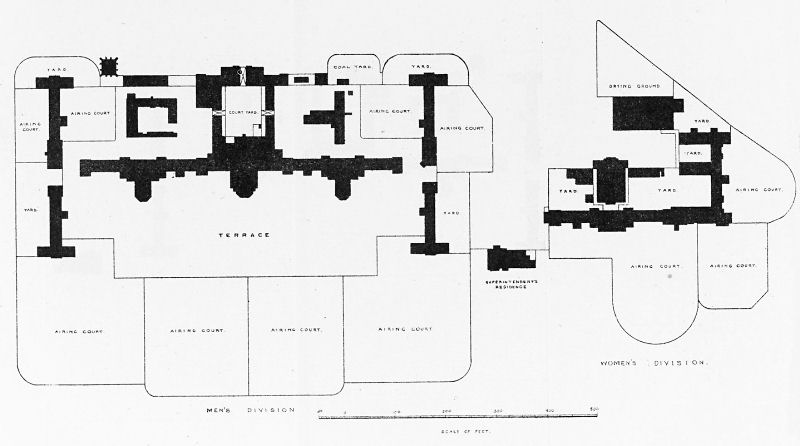
Broadmoor Asylum block plan, Crowthorne, Berkshire, 1887. © Peter Higginbotham

Broadmoor Asylum entrance gate from the north, Crowthorne, Berkshire, c.1910. © Peter Higginbotham

Broadmoor Asylum female quarters from the south-east, Crowthorne, Berkshire, c.1910. © Peter Higginbotham

Broadmoor Asylum male quarters from the south-west, Crowthorne, Berkshire, c.1910. © Peter Higginbotham

Broadmoor Asylum men's day room, Crowthorne, Berkshire, 1867.
The patient's accommodation was alsmost all in single rooms but the women's section also included several dormitories.
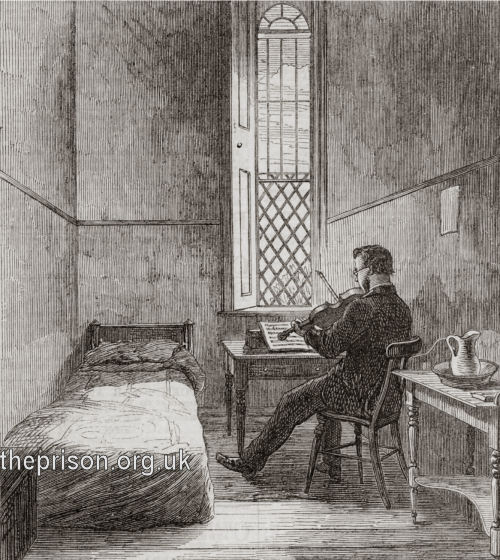
Broadmoor Asylum men's room, Crowthorne, Berkshire, 1867.

Broadmoor Asylum women's dormitory, Crowthorne, Berkshire, 1867.
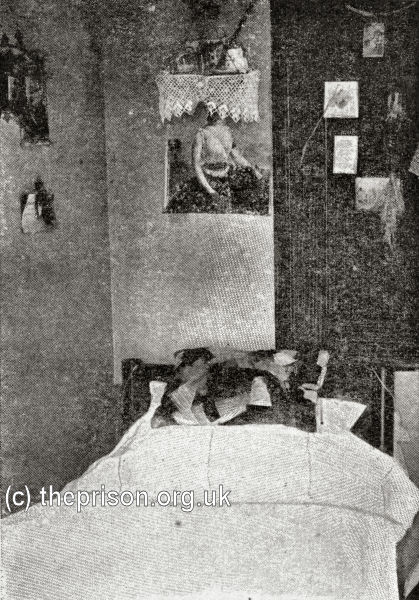
Broadmoor Asylum female patient's room, Crowthorne, Berkshire, c.1900. © Peter Higginbotham
At the rear of the central block in the men's section were workshops for upholstery, tailoring and shoe-making.
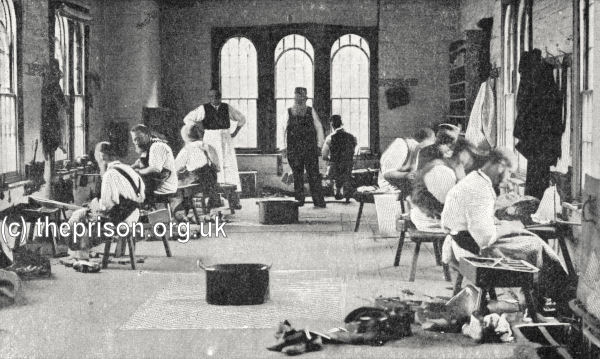
Broadmoor Asylum boot and shoe manufactory, Crowthorne, Berkshire, c.1900. © Peter Higginbotham
The asylum used special knives and forks that limited the harm that could be done in the hands of a violent patient.
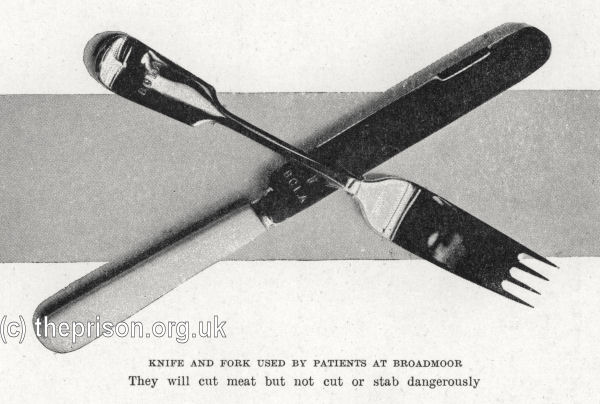
Broadmoor Asylum safety knife and fork set, Crowthorne, Berkshire, c.1900. © Peter Higginbotham
An additional male block was erected in 1902. In 1912, a shortage of places at Broadmoor led to the opening of a branch asylum at Rampton. After the arrangement was discontinued in 1919, Rampton was used to house what were then termed 'mental defectives'.
During the First World War, a prisoner-of-war camp, known as Crowthorne War Hospital, was established in Broadmoor's Block 1 (north-east of central building) to house for mentally ill German soldiers.
Broadmoor Hospital continues in operation to the present day.
Records
Note: many repositories impose a closure period of up to 100 years for records identifying individuals. Before travelling a long distance, always check that the records you want to consult will be available.
- Berkshire Record Office, Berkshire Record Office, 9 Coley Avenue, Reading, Berks RG1 6AF.
- The National Archives, Kew, Richmond, Surrey, TW9 4DU. Has a wide variety of crime and prison records going back to the 1770s, including calendars of prisoners, prison registers and criminal registers.
- Find My Past has digitized many of the National Archives' prison records, including prisoner-of-war records, plus a variety of local records including Manchester, York and Plymouth. More information.
- Prison-related records on
Ancestry UK
include Prison Commission Records, 1770-1951
, and local records from London, Swansea, Gloucesterhire and West Yorkshire. More information.
- The Genealogist also has a number of National Archives' prison records. More information.
Bibliography
- Stevens, Mark Broadmoor Revealed: Victorian Crime and the Lunatic Asylum (2020, Pen & Sword)
- Higginbotham, Peter The Prison Cookbook: A History of the English Prison and its Food (2010, The History Press)
- Brodie, A. Behind Bars - The Hidden Architecture of England's Prisons (2000, English Heritage)
- Brodie, A., Croom, J. & Davies, J.O. English Prisons: An Architectural History (2002, English Heritage)
- Harding, C., Hines, B., Ireland, R., Rawlings, P. Imprisonment in England and Wales (1985, Croom Helm)
- McConville, Sean A History of English Prison Administration: Volume I 1750-1877 (1981, Routledge & Kegan Paul)
- Morris, N. and Rothman, D.G. (eds.) The Oxfod History of the Prison (1997, OUP)
- Pugh R.B. Imprisonment in Medieval England (1968, CUP)
Links
- Prison Oracle - resources those involved in present-day UK prisons.
- GOV.UK - UK Government's information on sentencing, probation and support for families.
Except where indicated, this page () © Peter Higginbotham. Contents may not be reproduced without permission.



